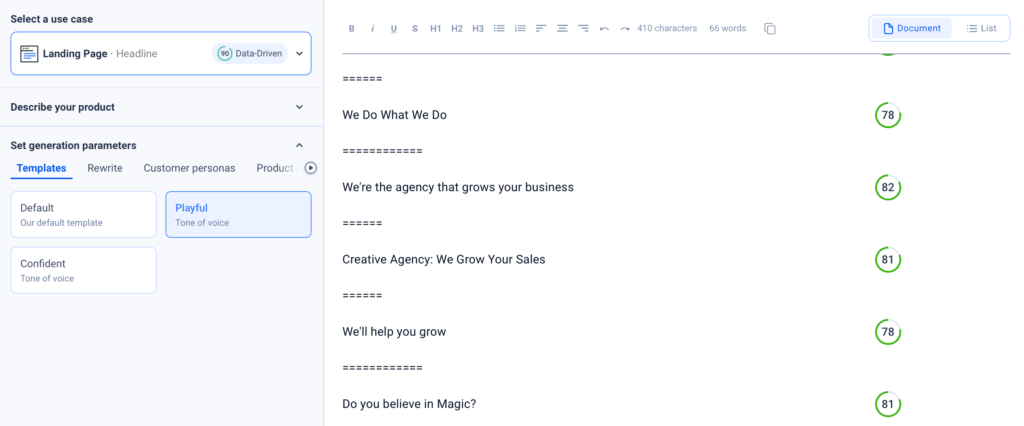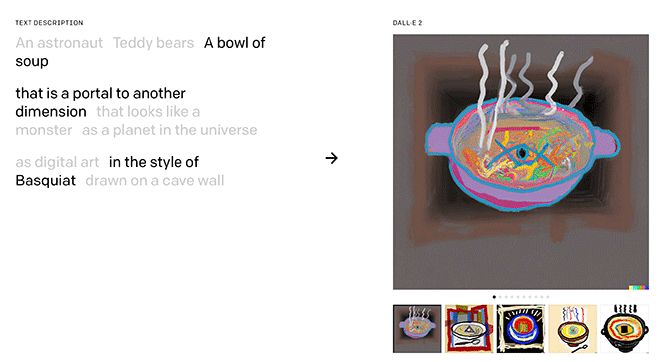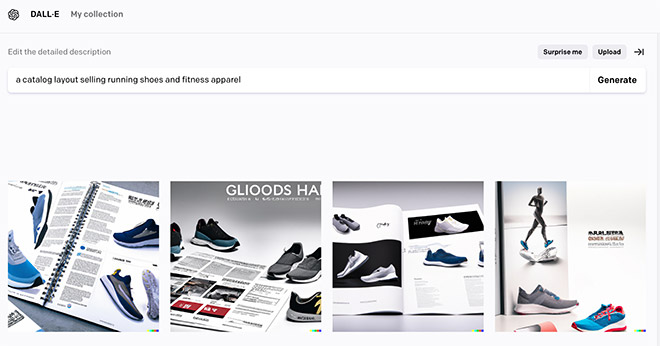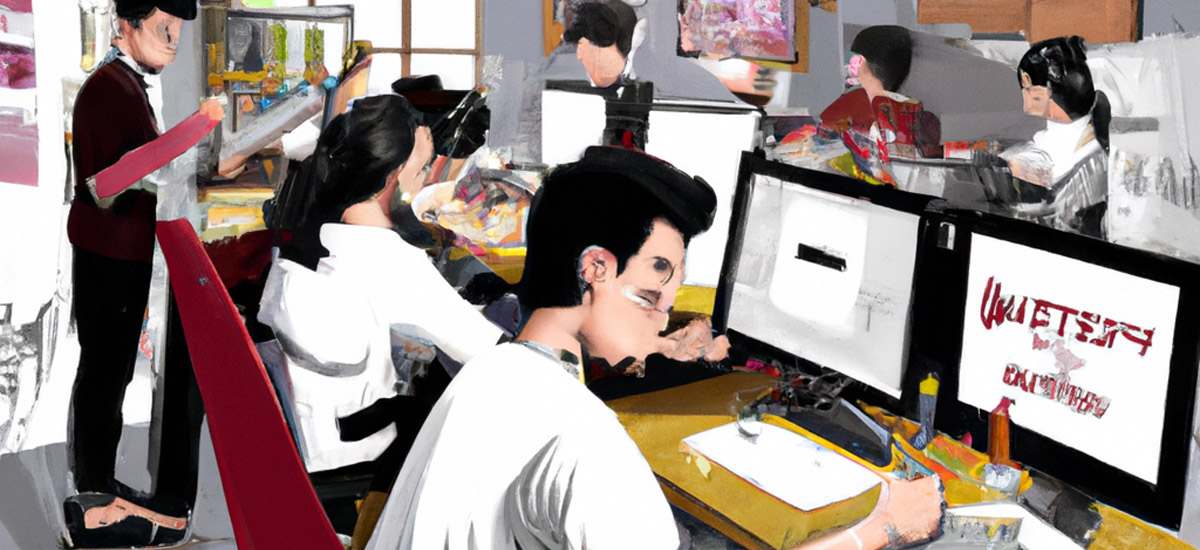
The Future of Marketing & The Rise of AI Powered Creativity
Artificial intelligence (AI) is changing everything from healthcare to transportation, but what does it mean for the future of creativity and advertising agencies? Like any other creative process, writing and design should be emotional, powerful, and a way to tell stories for products and brands. Using AI powered copy and image generation can help increase the speed by which we solve problems. But what does the future of marketing look like when it comes to incorporating AI in the design, brainstorming, writing, and general creative process? Is it another tool? Is it dangerous? How can artists and agency employees use it as it becomes more and more popular.
While it might seem like a distant science fiction future, AI design and copy are here – in fact the title of this article, the header image, and the introduction you just read weren’t created and written by myself, but by a computer algorithm. Join me as I dive into this brave new world, covering where AI creative currently stands, where it is likely to go, and some of the questions we should be asking ourselves along the way.
AI Copywriting
While AI programs may affect other sectors of marketing and agency work such as research into customer demographics and purchasing trends, for the sake of this piece I want to focus solely on the creative side of things, beginning with copywriting.
Put simply, AI copywriting is content generated by machine-learning software. Depending on the specific software, a user can input the kind of writing they are looking for (headlines, calls to action, etc.) some sample information about the product or brand (or a direct URL to pull data from) and then wait a few seconds as the algorithm scans millions of web pages looking for linguistic patterns and then uses these patterns to generate content on the inputted topic.
Here is an example of a simple test I did using our company website, www.j.schmid.com, as a base to draw information from. I asked the software (anyword) to come up with a playful new headline for our landing page:

As you can see the results range in efficacy and in interest, from the rather dull “Creative Agency: We Grow Your Sales” to the enticing, if a little grandiose, “Do you believe in Magic?”. The results can be refreshed endlessly, creating different headline lengths, new scenarios, and perhaps most importantly, a variety of perspectives and approaches. If at this point you’re thinking to yourself “But wait! Devon you’re a copywriter aren’t you worried about your job security and the rise of the machine overlords!?” I can thankfully reassure you that I am confident about the gainful employment of copywriters everywhere, for a few good reasons.
When it comes to AI copywriting there are some great use cases, but there are even more limiting factors. For starters, everything the software creates is based on an aggregate of massive amounts of data, and while that allows the program to work, it also disallows a level of net-new creativity that’s central to the writing process. For instance, in order to generate the opening paragraph to this article I had to input a paragraph of similar length that outlined more or less the same content the AI program ended up producing. It no longer sounded like me and it contained different phrases and tonal shifts, but it covered a similar outline of key information. While this might sound like a disadvantage, I think this is actually the hidden strength of AI copywriting. While it will always need a creative writer at the helm, these programs can be a reliable tool for quickly accessing different perspectives, sentence structures, and turns of phrase to reconsider the problem at hand and gain valuable insight in multiple ways it can be solved. What a thesaurus is for a single word, AI copywriting can be for sentences and entire paragraphs in the hands of a capable writer.
While using AI copywriting you will often be left with nonsensical headlines, tense disagreements, and verbs that fall flat – but in reviewing them you’ll see how not to solve the problem, which if nothing else, will always bring you closer to a solution in the end.
AI Design
While AI copywriting is fairly straightforward in both how it can be used and what it is capable of, AI design is much more complex in its creations and its lasting implications for creatives.
A central differentiator between AI copy and AI design is baked into the very process of each specific program. Whereas AI copywriting sorts through a massive aggregate data set in order to create content based on existing linguistic patterns, AI design uses machine learning to translate a text prompt into a net-new image by analyzing the semantic information of the text and then generating a visual manifestation of this information with an image decoder. Simple right? Since I’m a copywriter and you are just reading a blog, let’s stick to a high-level explanation. The AI program is fed all available image data, through machine-learning it starts to make connections between descriptions such as “a red apple” and images of “red apples”. With all of this data and some impressive programming it is then able to generate detailed, beautiful, funny, and sometimes terrifying images based on text prompts. (If you’d like to dive deeper into just how this works, I’d recommend watching this video https://youtu.be/F1X4fHzF4mQ)
They say pictures are worth a thousand words (much to my chagrin) but at the very least they break up my paragraphs, so let’s look at an example of this process in action. The image below was pulled from the DALL-E 2 landing page, you can interact with it yourself at https://openai.com/dall-e-2/.

While this is one of the most polished examples, featured prominently on their website, it is representative of the kind of detailed, original images programs like this are capable of creating. They don’t just translate your words, but can mirror well known art styles, textures, and combinations of elements into quickly generated images and art. The results can be honed and refined by the user, eventually creating a distinct and original style unique to a specific person and a specific text prompt.
While free form design and art creation are an astounding capability of AI design programs, in the world of marketing we often need to generate more specific and less open-ended images. With this in mind I wanted to experiment with how programs like DALL-E would handle something as niche as a catalog layout. Below you can see what I searched for and the four sample images that were generated:

While the results aren’t nearly as stunning as the cosmic Basquiat soup, there are some interesting elements under the alien-esque copy. First of all, these are the results of single search, no refinement, no refresh, just four original images. Secondly, there are some good design decisions in these mock-ups. Both images three and four contain many elements we look for in catalog design: hero images, use of negative space, lifestyle shots, and general design hygiene. They aren’t polished, they aren’t breath taking, but they would provide a place to start the conversation. In my opinion this is the biggest strength of AI design in an agency environment – to provide quick access to potential solutions and perhaps more importantly as a communication tool between creatives of all stripes. A writer can create a visual to help them communicate their ideas to a designer while a designer can give an idea of copy space to a writer, and they can both be entertained (and occasionally inspired) by what the AI produces.
So, What’s Next?
As with any new technology, the creative world is divided on its use, value, and potential. Some see it as a useful addition to the creative process that comes with some very real drawbacks:
While AI art and copy is an extension of human expression, and while it might make a job simpler and more efficient, the price we pay by using a program to mediate our ideas is that the final piece is a product of two variables (me and my computer) instead of one (me) – which means it’s farther from being personal to the artist by one deviation.
Skyler Baker, Designer ⎜ Illustrator
While others welcome AI creation as another access point to produce art, less reliant on notions of unnecessary personal sacrifice or institutional barriers:
AI will continue the technological trend of eroding the time it takes to get an inspiring idea into a workable format allowing artist of all kinds to create more… it’s not a new story in the history of creativity, it is a new tool and no tool can replace the fundamental ability of an artist to curate a message. Often people believe Sacrifice is what determines the value of art, time, material, etc… but if we examine value further, the most valuable pieces are valuable not because of these sacrifices but the curated message of the artist.
Mason Barry, Visual Designer at Whiskey Design
No matter where you fall on the spectrum of excited to fearful, I think it is important to remember that both AI copy and AI design still depend on one essential thing – a creative human being to wield them. Like other advancements before them, there will be successes and failures, things to learn and things to change, but above all if used judiciously, it can be another tool in the ever-growing toolbelt creatives have at their disposal. Famed graphic designer Brian Collins might have said it best:
Painters hated photography. Theatre people despised the movies. Movie executives feared television. Typographers mocked the Macintosh. But eventually, with the appearance of every new technology, each original discipline was transfigured into something more interesting, more complex, and (almost always) for the better.
*P.S. an alternate title for this article suggested by AI copy was “Brace Yourselves, Artificial Intelligence Is Coming For Everything We Hold Dear”. Do with that what you will…
Hoping to learn more about the latest trends in branding and agency creative? Reach out to Devon at devonc@jschmid.com.
Tags: Artificial Intelligence, Devon Clements, Technology

